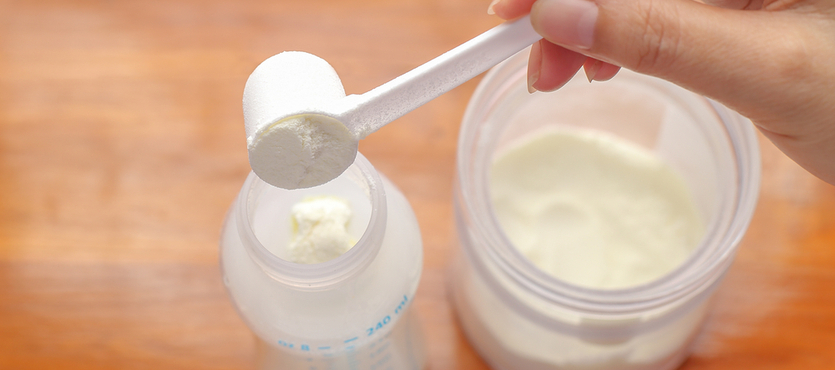A Florida mom recently picked up a can of Enfamil infant formula from her local CVS store, but when she got it home she noticed that something was not right. Alison Denning says she noticed that the formula smelled like baking flour. The container even had the protective seal intact on the lid when she bought it.
Inside the packaging, however, it looked like the product had been tampered with. She went to another CVS and bought another can of the formula which appeared more grainy and yellow like what is normal. CVS immediately pulled the powdered Enfamil formula off of its shelves nationwide, although Enfamil has not recalled the product.
CVS says they take the incident very seriously and are working with the supplier to find out what happened. As a precaution they removed all the product from the shelves until the investigation is completed.
Sadly, this is not the first report of infant formula being tampered with. A mother in Arizona bought a can of Enfamil formula from Walmart and it contained flour. In 2017, a woman from Arizona was charged with tampering and served seven months on probation for putting flour in infant formula cans so she could return them to the store for a refund.
Defective Product Injuries
Sadly, defective products cause thousands of injuries annually. Ranging from recalled vehicles and defective airbags, to hazardous toys and toppling furniture, too many products are sold to the public that can result in injuries. If you are injured by a defective product you may be entitled to damages from the manufacturer or designer of the product, as well as the importer, distributor, or seller. Anyone involved in the chain of distribution could be responsible for your injuries. However, there are a few ways that a defective product claim can be handled. These types of product liability claims include:
Design Defects
This type of liability claim is based on a defective design of a product. This type of civil action alleges that the product was inherently dangerous based on the design alone. It does not include injuries that resulted during the manufacturing of the product. An example of defective design is a car that is designed to be too top heavy and tips or rolls over. This would be an example of a product with a defective design that could result in a product liability lawsuit.
Florida statutes define a product as having a design defect if it is in a condition that is considered unreasonably dangerous to the actual user of the product or anyone in the vicinity of the product and the product can reach the user without any substantial change to the condition of the product. A product is unreasonably dangerous when it is used in the manner foreseeable by the manufacturer or designer and the danger of the product outweighs the benefits.
To prove a claim for defective design, you must be able to prove your relationship to the product, that the product was unreasonably defective and dangerous, and the existence of a causal connection between your injuries and damages and the product’s condition.
Manufacturing Defects
This type of claim is the most common cause of claims involving product liability. A manufacturing defect alleges that the design of the product was safe, but that something occurred during the manufacturing of the product that resulted in an unsafe product. The defect occurs if the product fails to conform to the original design and does not perform safely as the original design intended.
For example, if a set of tires was designed to support a certain vehicle weight and hold up against usual wear and tear, they would be considered safe to use. However, if the manufacturer gets sawdust into the adhesive glue that secures the tires, then they could have a high risk of tire separation, blowouts, and resulting serious accidents. This is an example of a manufacturing defect.
Warning and Labeling Defects
In this type of product liability claim, the plaintiff will allege that there was an inherent danger with the product and the manufacturer should have warned of the danger and failed to do so. This is most common with prescription medications. If a patient takes a medication and has a side effect that was not disclosed by the manufacturer, it could result in a defective product liability claim. Manufacturers are not required to warn of every single possible risk, but only risks that are recognized with the knowledge that is readily available.
Warning and labeling defects can be due to inadequate location of the warning, improper wording, or other factors of the manner in which the warning was delivered.
Compensation for Product Liability Injuries
Defective products can result in injuries that can be life-changing. They can also be costly and result in medical bills that quickly add up, especially if the injuries are long-term and require rehabilitation. In addition, some injuries may result in a person’s inability to work.
Victims of these injuries may be eligible for compensation for damages through a product liability lawsuit. This could pay for medical bills, pain and suffering, and lost wages. However, the Florida statute of limitations says that a person must file the lawsuit within four years of learning that his or her injury was caused by a defective product.
Contact a Product Liability Attorney
If you or your loved one has been injured due to a defective product, you may be entitled to damages and compensation for your injuries. The attorneys at Brill & Rinaldi can review your situation and determine what your best course of action may be. They have decades of experience helping their clients navigate through the complex legal system to get the compensation that they deserve. Contact them today to schedule a consultation.

